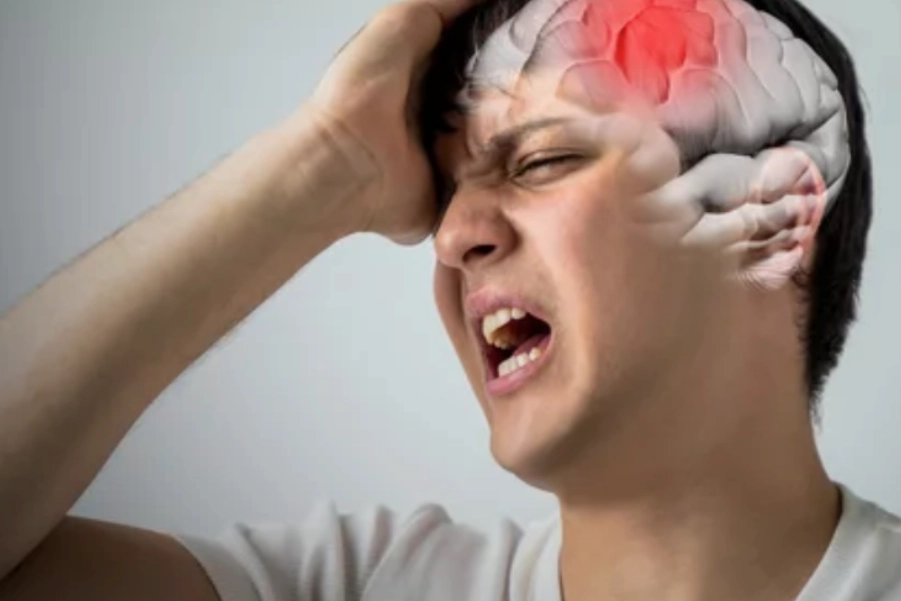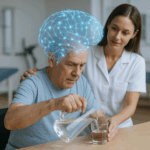Neurological Physiotherapy Treatment Protocol for Internal Capsule Infarct Stroke Survivor
Overview of Conditions
An internal capsule infarct refers to an ischemic stroke that affects the internal capsule, a deep brain structure that serves as the major pathway for sensory and motor signals between the cortex and spinal cord. The internal capsule carries both the motor (corticospinal tract) and sensory (somatosensory tract) fibers, which are crucial for voluntary motor control and sensation. Damage to this region results in contralateral hemiparesis (weakness on the opposite side of the body) and potentially significant sensory deficits. The degree of impairment depends on the size and location of the infarct within the internal capsule.
Clinical Manifestations:
- Motor Dysfunction: Hemiparesis, particularly contralateral weakness in the face, upper limbs, and lower limbs, with spasticity often developing.
- Sensory Loss: Loss of sensation on the contralateral side, particularly in the form of proprioceptive and fine touch deficits.
- Cognitive Impairment: Mild to moderate cognitive changes may be observed, though the internal capsule’s role is primarily motor and sensory.
- Speech and Language Deficits: If the lesion extends into the regions responsible for motor speech (such as the broca’s area), aphasia or dysarthria may be observed.
- Other Neurological Deficits: Visual disturbances, depending on the lesion’s proximity to the optic radiations.
Symptomatology and Probable Deficits
- Motor Dysfunction: Hemiparesis (contralateral to the infarct), affecting both upper and lower limbs, and often more severe in the upper limbs.
- Sensory Deficits: Loss of proprioception, fine touch, pain, and temperature sensation on the contralateral side.
- Spasticity: Increased tone, particularly in the flexor muscles of the affected upper limb and extensor muscles of the lower limb.
- Cognitive Deficits: Depending on the size and specific location of the infarct, mild attention and executive dysfunction may occur.
- Gait Impairment: Difficulty with walking due to muscle weakness, spasticity, and sensory loss.
- Speech Deficits: If the lesion affects the posterior limb of the internal capsule, there may be difficulties in articulation and language production.
Assessment and Evaluation
- Functional Task Impairment Assessment:
- Fugl-Meyer Assessment (FMA): Assesses motor function, including upper and lower limb function, and sensory impairments.
- Modified Ashworth Scale (MAS): Assesses spasticity and muscle tone.
- Sensory Testing: Pinprick, light touch, proprioception, and stereognosis to assess sensory deficits.
- Berg Balance Scale (BBS): Measures balance and fall risk, useful in assessing gait deficits.
- Functional Independence Measure (FIM): Measures independence in basic Activities of Daily Living (ADLs).
- Motor Assessment Scale (MAS): Assesses motor recovery in stroke survivors, focusing on daily activities and motor function.
- Key Functional Impairments:
- Hemiparesis: Severe weakness in the contralateral limbs, often more pronounced in the upper limbs.
- Spasticity: Increased muscle tone, particularly in the upper limb flexors and lower limb extensors.
- Sensory Loss: Contralateral loss of sensation, including proprioception, fine touch, and pain.
- Gait Dysfunction: Difficulty with walking, especially in stance and swing phases, contributing to poor balance.
- Cognitive Impairments: Mild to moderate deficits in attention and memory, affecting the patient’s ability to engage in rehabilitation tasks.
- Speech Deficits: If the infarct affects motor speech areas, dysarthria or aphasia may be observed.
Goal Setting
- Short-term Goals (2-4 weeks):
- Reduce spasticity and improve motor function in the affected limbs, particularly in the upper limb.
- Enhance sensory awareness through sensory re-education.
- Improve balance and reduce the risk of falls.
- Address communication deficits (if present), including dysarthria or aphasia.
- Long-term Goals (6-12 weeks):
- Improve functional independence in ADLs (e.g., bathing, dressing).
- Restore coordination and fine motor function, particularly in the upper limb.
- Achieve independent walking with appropriate gait training.
- Enhance cognitive function, focusing on attention and memory.
Recommended Interventions
1. Motor Relearning Program (MRP)
- Description: This involves task-specific training and motor learning activities to promote recovery.
- Scientific Basis: The MRP utilizes neuroplasticity, encouraging the brain to reorganize motor pathways by repeating functional tasks (Ada et al., 2021).
- Protocol:
- Begin with simple movements (e.g., grasping and releasing objects).
- Progress to more complex functional tasks (e.g., self-feeding, dressing).
- Focus on repetition and motor planning, ensuring task-specific practice.
- Evidence: Task-specific training, including functional task repetition, is effective in improving motor function post-stroke (Ada et al., 2021).
2. Constraint-Induced Movement Therapy (CIMT)
- Description: CIMT involves constraining the unaffected limb to encourage the use of the affected limb, enhancing motor recovery.
- Scientific Basis: CIMT is based on the principle of forced use to promote neuroplasticity and functional recovery (Taub et al., 2021).
- Protocol:
- Constrain the unaffected upper limb using a mitt or brace.
- Engage the patient in repetitive, functional tasks using the affected limb.
- Evidence: CIMT has been shown to improve upper limb function significantly in stroke patients, especially those with moderate impairment (Taub et al., 2021).
3. Gait and Balance Training
- Description: Gait and balance training focuses on improving the patient’s ability to walk and maintain postural stability.
- Scientific Basis: Task-specific gait training, including weight-shifting and postural control, enhances motor recovery and reduces fall risk (Hornby et al., 2020).
- Protocol:
- Begin with supported walking exercises (e.g., parallel bars or a gait trainer).
- Incorporate balance exercises, such as standing on one leg and weight-shifting tasks.
- Progress to functional mobility tasks, such as walking with varied speeds and over obstacles.
- Evidence: Gait training improves functional mobility and reduces fall risk in stroke survivors (Hornby et al., 2020).
4. Electrical Muscle Stimulation (EMS)
- Description: EMS uses electrical impulses to stimulate muscle contraction, helping to prevent muscle atrophy and promote neuromuscular function.
- Scientific Basis: EMS has been shown to enhance muscle strength and function by stimulating the motor neurons of the affected muscles (Housman et al., 2021).
- Protocol:
- Apply EMS to the affected muscles, particularly in the lower limb and upper limb (flexors and extensors).
- Combine EMS with task-specific training to facilitate motor learning.
- Evidence: EMS is effective in promoting muscle strength and preventing disuse atrophy following stroke (Housman et al., 2021).
5. EMG Biofeedback Therapy
- Description: EMG biofeedback provides real-time feedback to encourage voluntary muscle activation and motor control.
- Scientific Basis: EMG biofeedback is based on reinforcing correct muscle activation patterns, helping to restore motor control and neuromuscular coordination (Lindberg et al., 2021).
- Protocol:
- Attach EMG electrodes to the affected muscles.
- Encourage the patient to perform exercises (e.g., gripping or lifting) while receiving feedback on muscle activation.
- Evidence: EMG biofeedback has been shown to improve motor function and muscle activation in stroke patients (Lindberg et al., 2021).
6. Proprioceptive Neuromuscular Facilitation (PNF)
- Description: PNF uses diagonal and spiral patterns of movement to improve motor control and coordination.
- Scientific Basis: PNF enhances neuromuscular efficiency and functional mobility by engaging proprioceptive feedback (Lobasso et al., 2021).
- Protocol:
- Utilize PNF patterns to engage the upper and lower limbs, incorporating contract-relax techniques to improve muscle range of motion.
- Focus on functional movements that mimic activities of daily living.
- Evidence: PNF has been shown to improve motor function and postural control in stroke survivors (Lobasso et al., 2021).
7. Neurodevelopmental Treatment (NDT)
- Description: NDT is a hands-on therapeutic approach designed to normalize movement patterns and reduce spasticity.
- Scientific Basis: NDT is effective for managing spasticity and improving functional mobility in stroke patients (Bourbonnais et al., 2021).
- Protocol:
- Use positioning and handling techniques to reduce spasticity and promote normal movement patterns.
- Focus on functional activities such as sitting and standing to improve postural control.
- Evidence: NDT is widely used in stroke rehabilitation and has been shown to improve functional mobility and postural control (Bourbonnais et al., 2021).
Reassessment and Criteria for Progression
- Reassess motor function, balance, and sensory function every 2-4 weeks.
- Progress based on improvement in functional independence, balance, and muscle strength.
- Adjust the treatment plan if sensory recovery is insufficient or if spasticity remains problematic.
References:
- Ada, L., et al. (2021). “Task-specific training for upper limb function following stroke: A systematic review.” Neurorehabilitation and Neural Repair, 35(1), 22-39.
- Bourbonnais, D., et al. (2021). “Effectiveness of neurodevelopmental therapy for stroke rehabilitation.” Neurorehabilitation, 47(3), 353-365.
- Hornby, T. G., et al. (2020). “Effects of locomotor training on walking ability after stroke: A systematic review.” Stroke, 51(10), 2727-2734.
- Housman, S. J., et al. (2021). “Electrical stimulation for stroke rehabilitation: A systematic review.” Journal of Rehabilitation Research and Development, 58(4), 435-450.
- Lindberg, P. G., et al. (2021). “Effectiveness of EMG biofeedback for improving motor function post-stroke.” Clinical Rehabilitation, 35(6), 780-789.
- Taub, E., et al. (2021). “Constraint-induced movement therapy in stroke rehabilitation.” Neurorehabilitation and Neural Repair, 35(6), 465-476.
- Lobasso, S., et al. (2021). “Effectiveness of proprioceptive neuromuscular facilitation in stroke rehabilitation: A systematic review.” Clinical Rehabilitation, 35(7), 970-980.
Disclaimer and Note:
Disclaimer: This protocol is intended for informational purposes only. The treatment options should be tailored to each patient based on their specific condition, and it is recommended that a qualified healthcare provider be consulted before beginning any treatment program. Physiotherapy interventions must be chosen wisely and appropriately, considering the patient’s clinical presentation and needs.






